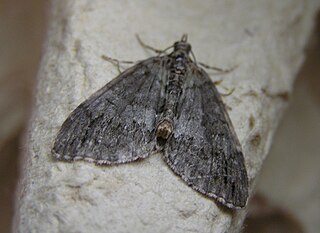
Renia is a genus of litter moths of the family Erebidae erected by Achille Guenée in 1854.
Euamiana is a genus of moths of the family Noctuidae erected by William Barnes and Foster Hendrickson Benjamin in 1927.

Grotella is a genus of moths of the family Noctuidae first described by Leon F. Harvey in 1875.
Properigea is a genus of moths of the family Noctuidae. The genus was erected by William Barnes and Foster Hendrickson Benjamin in 1926.
Redingtonia is a monotypic moth genus of the family Noctuidae. Its only species, Redingtonia alba, is found in the US state of Arizona. Both the genus and species were first described by William Barnes and James Halliday McDunnough in 1912.
Grossbeckia is a genus of moths in the family Geometridae. The genus was erected by William Barnes and James Halliday McDunnough in 1912.

Hydriomena is a genus of moths in the family Geometridae described by Jacob Hübner in 1825.
Schinia aetheria is a moth of the family Noctuidae first described by William Barnes and James Halliday McDunnough in 1912. It is found in North America, including Arizona, Nevada, New Mexico and Utah.
Idia terrebralis is a species of litter moth of the family Erebidae first described by William Barnes and James Halliday McDunnough in 1912. It is found in North America, including Illinois.
Bleptina sangamonia is a species of moth of the family Erebidae first described by William Barnes and James Halliday McDunnough in 1912. It is found in the US from Illinois and Maryland, south to at least South Carolina, but it is not present in Pennsylvania, New Jersey and Delaware.
Alpheioides is a genus of snout moths. It was described by William Barnes and James Halliday McDunnough in 1912, and contains the species Alpheioides parvulalis. It is found in North America, including southern California, Arizona and Oklahoma.
Anemosella is a genus of snout moths. It was described by Harrison Gray Dyar Jr. in 1914.
Decaturia is a monotypic snout moth genus. Its only species, Decaturia pectinalis, is found from California to southern Arizona. Both the genus and species were described by William Barnes of Decatur, Illinois, and James Halliday McDunnough in 1912.
Crambidia suffusa is a moth of the family Erebidae. It was described by William Barnes and James Halliday McDunnough in 1912. It is found in the US state of California.
Lycomorpha splendens is a moth of the family Erebidae. It was described by William Barnes and James Halliday McDunnough in 1912. It is found in North America, including Arizona, California, Nevada, New Mexico, Texas and Utah.
Givira cleopatra is a moth in the family Cossidae first described by William Barnes and James Halliday McDunnough in 1912. It is found in North America, where it has been recorded from Arizona, California, Nevada and Utah.
Thaumatopsis fieldella is a moth in the family Crambidae. It was described by William Barnes and James Halliday McDunnough in 1912. It is found in North America, where it has been recorded from California.
Lipocosma intermedialis is a moth in the family Crambidae first described by William Barnes and James Halliday McDunnough in 1912. It is found in North America, where it has been recorded from Texas and Maryland.

Eudonia spaldingalis is a moth in the family Crambidae. It was described by William Barnes and James Halliday McDunnough in 1912. It is found in North America, where it has been recorded from Alberta, Arizona, British Columbia, California, Colorado, Montana, Nevada, New Mexico, Utah and Wyoming.
Noctueliopsis puertalis is a moth in the family Crambidae. It was described by William Barnes and James Halliday McDunnough in 1912. It is found in North America, where it has been recorded from Arizona, California and Texas.


